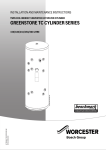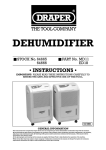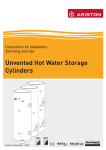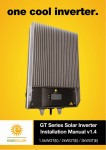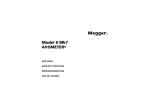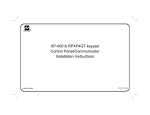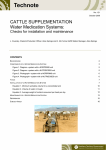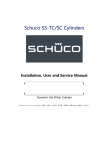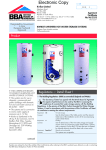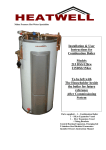Download ACV HR BE 160 Technical data
Transcript
smart line E SLE 130 – 300 IMPORTANT! DO NOT UNDER ANY CIRCUMSTANCES SWITCH ON THE IMMERSION HEATER BEFORE THE PRIMARY TANK IS FILLED. INDEX INTRODUCTION 1 Intended users of these instructions Warnings 1 1 1. Operation 2 2. Construction 3 3. Installation Domestic 4 Wiring the thermostats 5 Primary 5 Immersion Heater 6 4. Commissioning 7 5. Maintenance 8 6. Technical Data 9 7. Performance 10 8. System Schematics Typical un-vented Typical open vented Typical ‘S-Plan’ electrical Typical ‘Y-Plan’ electrical 9. Discharge Pipe Extract of ‘Building reg. G3’ 11 11 12 13 14 15 10. Parts List 16 11. Technical Assistance & Order Info. 16 T E C H N I C A L A N D I N S T A L L A T I O N INTRODUCTION Intended users of these instructions: - The specifying engineer. The installation engineer. The owner or user. The service engineer. Warnings. THE INSTALLER MUST READ AND UNDERSTAND THIS MANUAL BEFORE FITTING THIS APPLIANCE. IMPORTANT: Do not under any circumstances switch on the immersion heater before the primary tank is filled. Serious damage may result to the heater in addition to danger of personal injury and damage to property if the heater is switched on when dry. IMPORTANT: Always isolate electrical supplies and if necessary the water supply before working on the unit. IMPORTANT: Always fill and pressurise the secondary (domestic) tank first, filling and pressurising the primary (heating) tank may result in crushing damage to the domestic tank. IMPORTANT: ACV recommends the use of a corrosion inhibitor in the primary (heating) system. The warranty will be invalidated if upon inspection it is found that a tank has failed due to corrosion caused by the lack of an inhibitor. These instructions form an integral part of the equipment to which they refer and the user must be provided with a copy. The product must be installed and serviced by qualified engineers, in compliance with current standards. ACV cannot accept liability for any damage resulting from incorrect installation or from the use of components or fittings not specified by ACV. Any failure to follow the instructions regarding tests and test procedures may result in personal injury. ACV reserves the right to change the technical specifications and components of its products without prior notice. 1 T E C H N I C A L A N D I N S T A L L A T I O N 1. OPERATION A = Stainless steel internal tank B = STW 22 carbon steel exterior tank C = High density polyurethane foam insulation D = Heating fluid entry point E = Heating fluid outlet point F = Sanitary hot water outlet G = T & P relief valve connection H = Cold water inlet I = Control thermostat K = Control thermostat pocket L = Primary air vent M = Co-polymer polypropylene top cover N = Co-polymer polypropylene jacket Principle: ACV Tanks (tank in tank) comprise of two concentric water cylinders. Tank (A) is manufactured in solid stainless steel and contains the domestic water for use at the sanitary hot water outlets. The exterior tank (B) is manufactured from STW 22 carbon steel, this tank holds the primary heating fluid which is circulated from the boiler, as the primary fluid passes between the two tanks the heat is transferred to the domestic water. Operation: When the thermostat (I) calls for heat the primary pump is activated (or motorised valve is opened) and primary fluid is circulated in the outer tank and transfers its heat to the domestic water. Once the thermostat set temperature is achieved it will open and deactivate the primary pump (or close the motorised valve). Initial heating from cold will take between 10 and 20 minutes (depending on tank size and boiler output) – when operating temperature is achieved the recovery becomes faster. Operational Cycle: 2 T E C H N I C A L 2. A N D I N S T A L L A T I O N CONSTRUCTION Internal tank: This tank is the heart of the assembly; it has to withstand the corrosive nature of mains water and the temperature variations of stored water whilst working at high pressures. It is manufactured from solid stainless steel and welded in an inert Argon atmosphere (Argon Arc). Before being assembled the tank material is subjected to a rigorous cleaning and passivation process to increase its resistance to corrosion. The inner tank is also corrugated which allows it to freely expand and contract with temperature and pressure variations, shrugging off any lime scale deposits. Due to this, the tank does not require an inspection cover to facilitate the removal of lime. Insulation: High density injected polyurethane foam – 50mm thick. Containing no CFC’s. Jacket: The tank is covered in a co-polymer polypropylene jacket, this is a plastic material that offers a high resistance to impact and is also aesthetically pleasing. Controls: The tanks come complete with a control and high limit thermostat built into the top cover of the jacket. Thermostat control: The control is graduated from 1 to 5, 1 is minimum = 60°C and 5 is maximum = 90°C. In the case of a prolonged absence precautions must be taken to ensure there is no risk of freezing. The tank is delivered with the thermostat pre-set to a minimum of 65°C to eliminate the risk of legionella bacteria forming and complies with the recommendations of the World Health Organisation. The thermostat control dial can be removed to allow lower temperature settings, see sketch and description below. Modifying the IMIT thermostat: 1. Remove the control dial. 2. Take out the metal spring stop. 3. Replace the control dial. 3 T E C H N I C A L 3. A N D I N S T A L L A T I O N INSTALLATION (130 to 300 Smart Paks) Domestic: Parts List. 1. Pressure control valve 3.5bar. 2. Expansion vessel 3.5bar. 3. Check/Expansion valve assembly 6bar. 4. Thermostatic mixing valve. 5. Temperature & pressure relief valve 7bar. 6. Tundish. 1 in No. 22mm equal tee. 1 in No. 22mm elbow. 2 in No. 22mm x 3/4" FI BSP Adaptors. 5 lengths 22mm Copper tube (A to C on drawing). Note: Secondary return pipework and fittings are not included in the kit. Guidance for Installation. 1. Connect 22mm x 3/4" FI BSP adaptors to cold water inlet (blue) and hot water outlet (red) connections on tank. installed correctly, cold/hot inlet ports are marked on body, i.e. hot to H cold to C outlet to MIX. Note:- discharge pipework to tundish is not supplied. 3. Orientate mixing valve hot water outlet to desired position and tighten. 4. Connect Check/Expansion valve to cold water inlet pipe (A) and orientate Expansion vessel connection to suit installation. 5. Connect Pressure Reducing Valve to Check/Expansion valve (a light smear of jointing compound to PTFE ring will ease assembly) and orientate to ensure balanced cold water take-off faces either front or rear (blank supplied if take-off is not to be used). 6. Remove 3/4" black plastic plug from Check/Expansion valve and fit Expansion Vessel (seal with PTFE tape). 7. Connect Temperature and Pressure relief valve to 1/2" connection and orientate into position. Do not run drain discharge pipework across top of tank. 8. Connect both Temperature and Pressure relief valve/Expansion valve discharge pipework across top of tank. 9. Install Tundish outlet pipework as per Building regulation G3 (for further guidance refer to controls installation and maintenance instructions). Flush pipework and commission. 4 T E C H N I C A L A N D I N S T A L L A T I O N Wiring the thermostat: To comply with ‘The Building Regulation 1991 G3.6’ the manual reset high limit thermostat must be wired to a self-closing motorised valve or some other suitable device to shut off the primary flow to the cylinder. The thermostatic controller should be used to regulate the temperature of the tank by controlling the heating pump or zone valve supplying the unit (note that a spring return valve must be connected to the high limit stat for normal operation, i.e. the valve will be energised to open by the thermostat and then spring closed when the circuit is broken). The switch wire from the pump or valve can be wired to the tank controls via the 6 pin plug. See diagram below. Thermostat wiring schematic. High Limit Stat Thermostat Factory Wired Installer Wired Please note N is a switched LIVE not NEUTRAL. (Typical ‘S & Y-plan’ wiring schematics are on pages 12 &13). ACV recommend that the cylinder is electrically cross bonded to earth. Primary system connections: The primary flow and return connections to the tank should be made using the appropriate sized fittings with a male BSP component that will allow the disconnection and removal of the unit. A self-closing motorised valve or some other suitable device must be fitted to shut off the primary flow to the cylinder. Care must be taken to ensure that the connections are watertight to avoid any leakage that may go undetected and cause external corrosion damage to the tank. Distribution Pressure The mains water supply must be fed to the unit via the supplied mains kit, this will maintain a maximum distribution pressure of 3.5 Bar. Purging After filling and before using it will be necessary to purge air from both the primary (heating) and secondary (domestic) tanks. The domestic can be purged by opening a hot outlet at the highest point (or by venting the temperature and pressure relief valve), the primary (heating) tank can be vented using the air vent located on the top of the tank (ensure vent is tightened after use). 5 T E C H N I C A L A N D I N S T A L L A T I O N Immersion Heater The SmartLineE range of tanks have the facility for fitting a 3kW immersion heater for back-up emergency use when the primary heating fails not as a permanent form of summer time heating, this heater must be wired to its own 13 Amp fused spur and as described in the installation instructions for Thermtec immersion heaters. Installation Instructions for Thermtec Immersion Heaters Series AF, BF, CF, DF, AD, BD, CD, DD. 1. Ensure mains voltage corresponds to the voltage rating of the heater as shown on the rating label on the terminal cover. 2. Install the heater into the water tank, using the gasket or ‘O’ ring supplied (the use of sealing compounds is not recommended). Use a shaped spanner to tighten (stillsons should not be used). 3. It is essential that water fully covers the heating element to a depth of at least 100mm. Under no circumstances must the heater be permitted to run dry – serious damage may result to the heater in addition to danger of personal injury and damage to property. 4. Check for possible leakage before wiring. 5. Wire the heater in accordance with the diagram below. The heater should be wired through a double pole isolating switch or controller, having contact separation of at least 3mm using 1.5sqmm flexible cable, 85°C rubber insulated HOFR sheathed, complying with BS6141 Table 8. It must be fully earthed. Ensure all terminals are securely made, however do not use excessive force when tightening. 6. BEAB approval will only apply to this heater if the following thermostats are used: Series AD, BD, CD, DD control thermostat – Diamond H WT Series or Sunvik VKL Series. Re-settable master thermostat – Sunvik Series VKL and Thermtec SK. Series AF, BF, CF, DF. Thermowatt type RTS-3 thermostat. 7. In the event of the manually resettable cut out operating, isolate the heater from the mains, investigate and identify the cause of cut out, rectify before resetting and then reenergise the heater. Replace the terminal cover securely before re-energizing. 8. All heaters conform to EEC directive 76/889 for radio interference and comply with BS 800:1977. BEAB APPROVED Heater Series AD, BD, CD, DD Heater Series AF, BF, CF, DF WARNING! UNDER NO CIRCUMSTANCES CAN THE IMMERSION HEATER BE SWITCHED ON BEFORE THE PRIMARY TANK IS FILLED. SERIOUS DAMAGE MAY RESULT TO THE HEATER IN ADDITION TO DANGER OF PERSONAL INJURY AND DAMAGE TO PROPERTY IF HEATER IS SWITCHED ON WHEN DRY. 6 T E C H N I C A L 4. A N D I N S T A L L A T I O N COMMISSIONING Characteristics: Maximum water supply pressure to the reducing valve Operating pressure Expansion vessel charge pressure Expansion valve setting Maximum primary working pressure Temperature & pressure relief valve pressure setting Temperature & pressure relief valve temperature setting 16 Bar 3.5 Bar 3.5 Bar 6 Bar 3 Bar 7 Bar 92-95 °C 1. Flush the tank with fresh mains water then fill, vent and pressurise domestic water circuit as previously described. IMPORTANT: Always fill and pressurise the secondary (domestic) tank first, filling and pressurising the primary (heating) tank may result in crushing damage to the domestic tank. 2. Fill the primary circuit taking care not to exceed 2 Bar. 3. Purge the air from the primary tank. 4. Switch on and operate. IMPORTANT NOTE: ACV recommends the use of a corrosion inhibitor in the primary (heating) system. The warranty will be invalidated if upon inspection it is found that a tank has failed due to corrosion caused by the lack of an inhibitor. 7 T E C H N I C A L 5. A N D I N S T A L L A T I O N MAINTENANCE ACV recommend that the cylinder is maintained by a competent person, this should be carried out every 12 months. The safety valves must be manually operated at least once a year to check their operation and reseating. Allow cylinder to cool before slowly twisting open the temperature and pressure relief valve. The water should flow freely through the tundish and discharge pipe work, check that the valve reseats when released. CAUTION: The water discharged may be very hot. Repeat the steps above for the expansion relief valve on the cold inlet pipe work. The pressure reducing valve (PRV) has a strainer that can be removed for inspection and if necessary cleaning. i. ii. iii. iv. v. vi. Isolate the cold water inlet to the cylinder. Open the lowest hot tap to remove the pressure from the system. The black plastic PRV cartridge can be unscrewed from the brass valve body, loosen using a suitable spanner (not stilsons or pump pliers) unscrew and pull the cartridge from the valve body, the strainer will be withdrawn with the cartridge. Remove the strainer from the cartridge and clean under running water if necessary. Replace strainer and push cartridge into valve body, take care when screwing the cartridge in not to damage the threads. Do not over tighten. Close hot tap and slowly open the cold water isolating valve to the cylinder, check for any leaks. The primary tank should be checked for a build up of air, this can be purged using the primary air vent on the top of the cylinder. Check the primary system pressure gauge on the boiler or filling loop and recharge as necessary. IMPORTANT: If the primary system is being topped up on a regular basis there is a risk of corrosion damage to the cylinder. The tank must be fitted by means of screwed couplings or flanges to allow dismantling and removal of the unit. These should be fitted in such a way as to allow easy access. 8 T E C H N I C A L 6. A N D I N S T A L L A T I O N TECHNICAL DATA Type Code Unvented Kit Total Capacity (ltrs) Heating Fluid Capacity (ltrs) Domestic Water Capacity (ltrs) Primary press. drop (mbar) Immersion heater connection Primary fluid connections Domestic water connections Dimension: A (mm) B (mm) C (mm)* Weight empty (kg) Weight full (kg) Heating surface (m²) Primary fluid flow (ltrs/hr) Absorbed Power (kW)** Start-up time from 10 to 85°C(min) SLE 130 06604801 130 55 75 17 1½” BSP 1” BSP ¾” BSP 525 960 1460 55 185 1.03 2100 23 22 SLE 160 SLE 210 06604901 06605001 Smart Pak1 (12ltr) 161 203 62 77 99 126 22 37 1½” BSP 1½” BSP 1” BSP 1” BSP ¾” BSP ¾” BSP 725 997 1160 1435 1660 1935 65 75 226 278 1.26 1.54 2600 3500 31 39 22 20 SLE 240 06605101 242 78 164 45 1½” BSP 1” BSP ¾” BSP 1244 1680 2180 87 329 1.94 4200 53 20 SLE 300 06605201 SP2 (18ltr) 293 93 200 51 1½” BSP 1” BSP ¾” BSP 1550 1988 2488 102 395 2.29 5300 66 20 * Dimension C is the approximate total height with mains kit fitted including expansion, please be aware that this kit is adaptable should there be a restriction on the height. Please contact ACV UK Ltd technical support for any assistance. ** The boiler outputs shown are the minimum to provide the domestic performance figures detailed. Should a lower capacity boiler be used the performance will be reduced. 9 T E C H N I C A L 7. A N D I N S T A L L A T I O N PERFORMANCE Performances Type 1st hour output (ltrs/60min) Peak output (l/10min) 40°C 236 321 406 547 700 SLE 130 SLE 160 SLE 210 SLE 240 SLE 300 45°C 202 275 348 469 600 60°C 117 161 209 272 337 Operating conditions: * 40°C 784 1063 1349 1820 2319 45°C 672 911 1156 1560 1988 60°C 384 549 689 913 1165 primary fluid cold inlet Continuous output (ltrs/hr) 40°C 658 890 1132 1527 1943 45°C 564 763 970 1309 1665 60°C 320 465 576 769 994 Boiler Output (kW)* Primary flow rate (ltrs/hr) Heat up time 10°C–85°C (min) 23 31 39 53 66 2100 2600 3500 4200 5300 22 22 20 20 20 85°C 10°C The boiler outputs shown are the minimum to provide the domestic performance figures detailed. Should a lower capacity boiler be used the performance will be reduced. 10 T E C H N I C A L 8. A N D I N S T A L L A T I O N SYSTEM SCHEMATICS Typical un-vented application. Typical open vented application. 11 T E C H N I C A L A N D I N S T A L L A T I O N Typical ‘S-Plan’ schematic. CONTROL TERMINAL NUMBERING MAY DIFFER FROM THOSE SHOWN. ALWAYS REFER TO THE INSTRUCTIONS SUPPLIED WITH YOUR CONTROL PACKAGE. ACV 6 PIN SOCKET FACTORY WIRED N IS SWITCHED LIVE NOT NEUTRAL 12 THIS DIAGRAM IS FOR GUIDANCE ONLY. ACV ACCEPT NO LIABILITY FOR DAMAGE TO EQUIPMENT ARISING FROM ERRORS OR OMISSIONS INADVERTENTLY CONTAINED WITHIN THIS DIAGRAM. T E C H N I C A L A N D I N S T A L L A T I O N Typical ‘Y-Plan’ schematic. CONTROL TERMINAL NUMBERING MAY DIFFER FROM THOSE SHOWN. ALWAYS REFER TO THE INSTRUCTIONS SUPPLIED WITH YOUR CONTROL PACKAGE. SWITCH WIRES ON 2 PORT VALVE ARE NOT REQUIRED. ACV 6 PIN SOCKET FACTORY WIRED N IS SWITCHED LIVE NOT NEUTRAL 13 THIS DIAGRAM IS FOR GUIDANCE ONLY. TO EQUIPMENT ARISING FROM ERRORS OR OMISSIONS INADVERTENTLY CONTAINED WITHIN THIS DIAGRAM. T E C H N I C A L 9. A N D I N S T A L L A T I O N DISCHARGE PIPE The discharge pipe (D2) from the tundish should terminate in a safe place where there is no risk to persons in the vicinity of the discharge, be of metal and: a. be at least one size larger than the nominal outlet size of the safety device unless its total equivalent hydraulic resistance exceeds that of a straight pipe 9m long i.e. discharge pipes between 9 and 18m equivalent resistance length should be at least two sizes larger than the nominal outlet size of the safety device, between 18 and 27m at least 3 sizes larger, and so on. Bends must be taken into account in calculating the flow of resistance. Refer to Diagram 1, Table 1 and the worked example overleaf. b. have a vertical section of pipe at least 300mm long, below the tundish before any elbows or bends in the pipework. c. be installed with a continuous fall. d. have discharges visible at both the tundish and the final point of discharge but where this is not possible or is practically difficult there should be clear visibility at one or other of these locations. Examples of acceptable discharge arrangements are: i. ideally below a fixed grating and above the water seal in a trapped gully. ii. downward discharges at low level; i.e. up to 100mm above external surfaces such as car parks, hard standings, grassed areas etc. are acceptable providing that where children may play or otherwise come into contact with discharges a wire cage or similar guard is positioned to prevent contact, whilst maintaining visibility. iii. discharges at high level; e.g. into a metal hopper and metal down pipe with the end of the discharge pipe clearly visible (tundish visible or not) or onto a roof capable of withstanding high temperature discharges of water and 3m away from plastic guttering system that would collect such discharges (tundish visible). iv. where a single pipe serves a number of discharges, such as in blocks of flats, the number served should be limited to not more than 6 systems so that any installation discharging can be traced reasonably easily. The single common discharge pipe should be at least one pipe size larger than the largest individual discharge pipe (D2) to be connected. If un-vented hot water storage systems are installed where discharges from safety devices may not be apparent i.e. in dwellings occupied by blind, infirm or disabled people, consideration should be given to the installation of an electronically operated device to warn when discharge takes place. Note: The discharge will consist of scalding water and steam. Asphalt, roofing felt and nonmetallic rainwater goods may be damaged by such discharges. 14 T E C H N I C A L A N D I N S T A L L A T I O N Extract from ‘The Building Regulations 1991 G3’ 15 T E C H N I C A L A N D I N S T A L L A T I O N 10. PARTS LIST Description 300mm Immersion Heater 11/2" BSP 3KW Thermostat pocket Manual air vent Control thermostat Manual reset high limit thermostat 90°C Sparge pipe Ø19.5mm, length 700mm Smart 130 Sparge pipe Ø19.5mm, length 870mm Smart 160 Sparge pipe Ø19.5mm, length 1070mm Smart 210 Sparge pipe Ø19.5mm, length 1340mm Smart 240 Sparge pipe Ø19.5mm, length 1590mm Smart 300 11. TECHNICAL ASSISTANCE & ORDER INFORMATION Telephone: 01383 820 100 Fax: 01383 820 180 e-mail: [email protected] web address: www.acv-uk.com ACV UK Ltd. St. Davids Business Park Dalgety Bay Fife KY11 9PF Scotland Manufactured at: ACV International Kerkplein 39 B – 1601 Ruisbroek Belgium Telephone: 0032 237 81235 e-mail: [email protected] web address: www.acv.com 16 Code OI300 438027 445006 54442045 54764020 497b0003 49410116 49410170 49410043 49410169




















